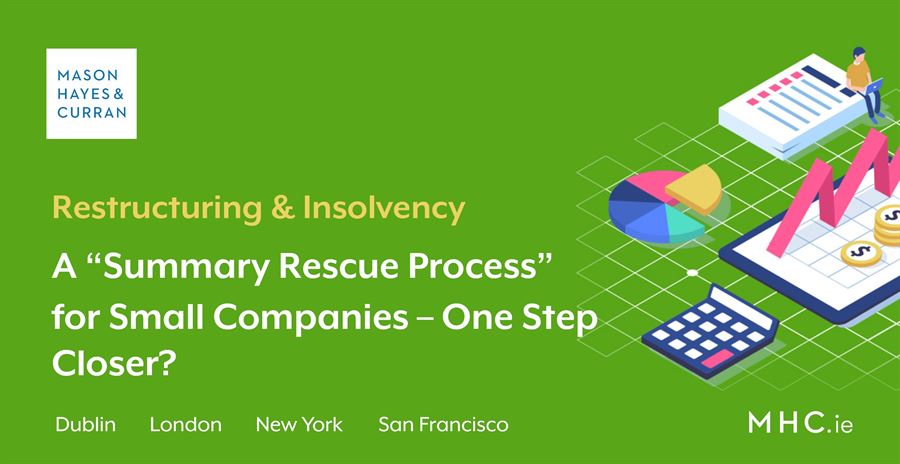
The Department of Enterprise, Trade and Employment commenced a public consultation process on 8 February 2021, in relation to proposed legislation which will allow for a new restructuring procedure for the rescue of small companies.
It is envisaged that the legislation, if enacted, will set out a stand-alone restructuring process separate from examinership. This new process will be tailored specifically for the 98% of Irish companies that are “micro” and “small” companies as defined in the Companies Act 2014. This includes all companies that, in the most recent financial year, fulfil two or more of the following requirements:
-
The turnover of the company does not exceed €12 million
-
The balance sheet total of the company does not exceed €6 million
-
The average number of employees does not exceed 50
The consultation process follows the publication of a report by the Company Law Reform Group (CLRG) in October 2020, which in summary recommended that any such process should:
-
Have a primary purpose of saving the company and any jobs it provides
-
Be commenced by resolution of directors, rather than by application to Court
-
Be concluded within a shorter period than examinership
-
Be overseen and assisted by insolvency practitioners, known as “Process Advisors”[1]
-
Require that the company has a reasonable prospect of survival
-
Provide that the rescue plan be passed by a simple majority in value of creditors
-
Provide for a format of cross-class cram down of debts
-
Not require application to Court for approval of the rescue plan, provided there are no creditor objects, and
-
Have safeguards against irresponsible and dishonest director behaviour
The SME sector has not widely availed of examinership, despite the introduction of the “examinership light” reforms in 2013[2]. The reforms allowed for the examinership of small companies to be under the jurisdiction of the Circuit Court. This may be because of the relative expense of the process. It is anticipated that the “Summary Rescue Process” will be considerably less expensive than examinership.
It is anticipated that the process will involve no or minimal court input or supervision. While that may offer efficiencies and savings, it will be important to ensure that some of the safeguards that the Court provides in examinership are included[3].
While some key issues must be addressed, in the current economic environment such a procedure will likely be welcomed by the SME sector.
Q: Will there be an automatic stay on proceedings or enforcement upon commencement of the process?
A: The current CLRG recommendation is that rather than an automatic stay, the company will have an ability to apply to Court for a stay, if required. The logic behind this is that an automatic stay would require court involvement, at the commencement of the process. This would add significantly to the cost. Without an automatic stay there is a risk that creditors will act swiftly to exercise their rights, rendering a rescue process somewhat futile.
Q: How will onerous contracts be addressed?
A: Section 537 of the Companies Acts allows for the repudiation of onerous contracts in certain circumstances. The CLRG did not reach a consensus on this point and it may be that there will be no provision for repudiating onerous contracts in the new process.
Q: Will any debts be excluded from cram down?
A: It is envisaged that employees will be excluded from any cram down provisions, and will presumably remain subject to the existing legislative protections afforded to them. The question of whether Revenue will have an option to “opt in” or remain outside any procedure [4] is still unclear. Presumably, secured creditors may have the right to remain outside of the process and elect to deal separately with any secured assets, subject to any automatic stay that may be imposed, but this is not clarified.
Q: Will a court have to approve of any cross-class cram down?
A: Yes – under the CLRG recommendations the approval of the Court may be required where a cross-class cram down of any kind is part of the proposal.
In conclusion, while there is still some way to go, the Summary Rescue Process, if implemented and utilised correctly, has the potential to have a positive impact on the SME sector and become an important insolvency tool.
For more information, please contact a member of our Restructuring & Insolvency team.
[1] See the CLRG “Report Advising on a Legal Structure for the rescue of Small Companies” 22 October 2020 at paragraph 4.5.8.
[2] Under the Companies (Miscellaneous Provisions Act 2013), now section 509 (7) of the Companies Act 2014.
[3] For example, the automatic Court protection in the form of a moratorium on enforcement proceedings against the company.
[4] As is the case under the Personal Insolvency Act 2012.
The content of this article is provided for information purposes only and does not constitute legal or other advice.




